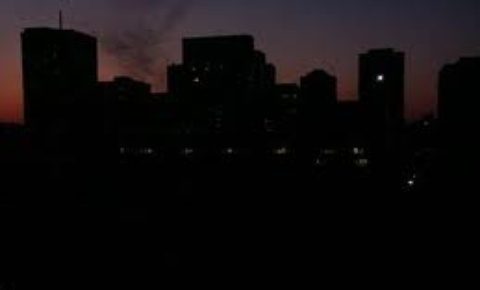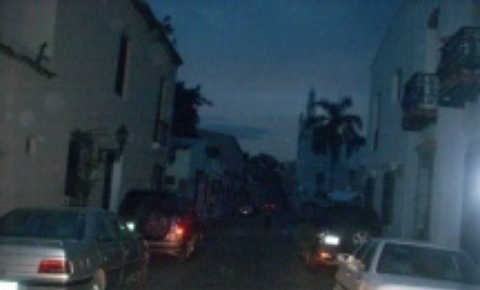Above: The Colonial Zone in Santo Domingo during a blackout (apagone).
It is rather ironic for me to being here in the Dominican Republic, a country which has its share of hurricanes each year and see news of Hurricane Sandy devastating the Northeastern United States, the part of the world I grew up in. Hurricane Sandy passed by here upon my arrival but she was a mere tropical storm back then, a wolf in sheep’s clothing.
The sheer fury of Sandy after she transformed into a hurricane was intense. I lived in lower Manhattan, less than two miles from the former World Trade Center, so seeing the pictures of the destruction brings it quite close to home. I have a lot of family living in the Northeast and I am thankful to report that all are fine. My sympathies go out to those that are suffering. I have read some very sad stories of the result of Sandy’s wrath. No laughing matter. So it is with total respect I write this post.
The irony is that although this country did not suffer under Hurricane Sandy like the Northeastern United States did, the aftermath of Sandy is a close approximation of daily life in a third world country.
We Americans like to feel like we care about the plight of third world countries so we send our money to charities, we mobilize through petitions and we may even go with a missionary group to one of these countries to build something or teach a bible school. All are noble intentions but none actually provide a real, visceral understanding of what daily life is like there. Hurricane Sandy, however, taught the Northeast in a visceral way what third world living can be like.
 Perhaps you think I’m being dramatic. Of course, you might say, third world countries experience power and water shortages but not flooding, destruction, loss of life due to weather or displacement. I would counter that depending on where you live these type of experiences are far too common and there is no FEMA or other agency swooping in to provide relief. Take a look at the map of the island of Hispaniola, the island which Haiti and the Dominican Republic share. Just about every hurricane that hits this island affects the area marked as the “flood disaster area”. It is an area which affects both Haiti and the Dominican Republic and some of the poorest people on the island live there, including many illegal immigrants from Haiti who have crossed the border. Each hurricane that hits swells the rivers in this area and floods the region. You hear reports of 20, 30, 40, 50 people dying from the rising waters and many more sick from the ensuing contamination and lack of drinking water. This happens several times a year here. For the residents of this area there is no solution, no relief. Even the money raised in the U.S. to help these victims rarely actually reaches them. There is so much corruption along the way.
Perhaps you think I’m being dramatic. Of course, you might say, third world countries experience power and water shortages but not flooding, destruction, loss of life due to weather or displacement. I would counter that depending on where you live these type of experiences are far too common and there is no FEMA or other agency swooping in to provide relief. Take a look at the map of the island of Hispaniola, the island which Haiti and the Dominican Republic share. Just about every hurricane that hits this island affects the area marked as the “flood disaster area”. It is an area which affects both Haiti and the Dominican Republic and some of the poorest people on the island live there, including many illegal immigrants from Haiti who have crossed the border. Each hurricane that hits swells the rivers in this area and floods the region. You hear reports of 20, 30, 40, 50 people dying from the rising waters and many more sick from the ensuing contamination and lack of drinking water. This happens several times a year here. For the residents of this area there is no solution, no relief. Even the money raised in the U.S. to help these victims rarely actually reaches them. There is so much corruption along the way.
There are many other places in third world countries which face the same issues when weather strikes, all without any real hope of change.

But what about the rest of the areas in those countries, the parts not regularly impacted by dramatic weather? Life can’t be that bad can it? Yes and no — it’s all a question of perspective. I have lived in two third world countries: Haiti and the Dominican Republic and my ex has lived in two as well: the Dominican Republic and India. The difference, however, is that I grew up, and was accustomed to, life in a first world country and he was not. I have said before that I think that every American should live in a third world country for part of their lives and this recent hurricane has only reinforced this belief.
Speaking on the Dominican Republic, the country I have the most experience with, I lived there on a middle class level for nearly eight years. I lived in the center of town, ran a business and raised a family. My monthly overhead, just to make ends meet was over $3000 for me and two kids, more than in the United States for a much higher standard of living. That combined with the fact that my ability to earn that much money was way more limited than in the United States made for a daily challenge to make ends meet. Although I lived in a nice neighborhood, the power went out regularly for a couple of hours a day. Water would also be unavailable for part of the day. But my area was relatively stable compared to others. When the power went out, it also took out the street lights so driving around town was extremely challenging at times.
When my finances got tight, I moved out of town a couple of miles. The first week I was there the power went out for three consecutive days. When the power was out the pump couldn’t run and there was no water pressure, ie., no water. Power was out regularly for 12-18 hours a day. No storm, no special circumstances, just life.
When the power goes out in a third world country it is not an emergency, it is normal, so there are no generators brought in so people can charge their cell phones. No one shares their power. The people without power just have to deal with it and wait.

The thing is, us Americans and others who our norm is power and water 24/7, tend to be dismissive of the situation in third world countries. I don’t think it is because we don’t care but because we don’t know what we can do about it and therefore we just write it off as unfortunate situation which the residents have managed to survive. But we must not mistake being able to deal with the challenges of living in a third world country with not being impacted by those challenges.
The reality is that the lack of a basic infrastructure in third world countries such as a constant supply of water and power plus things like trash removal, maintained roadways, and safe, public spaces, directly impacts the people that live in these areas. This lack impacts their:
- productivity
- safety
- cleanliness
- motivation

The limits of the infrastructure in these countries keep their inhabitants from advancing. The expenses and hurdles of running a business, for example, in one of these countries is enormous. One needs a power and water back up system, security guard or highly-secure office which is very expensive, bribes to the public service officials to keep your street clean and safe, bribes to the tax officials because the standard tax rate would close your business and even with all that you can still be without power, water, internet, phone or any other service you need to run your business. Outside your front door, even in a nice neighborhood, is not necessarily safe. I had my purse stolen out of my car as I was entering my car into my garage. A client had his car stolen parked in front of my office.
But people in third world countries actually appear happier in many ways than most Americans do. This is because the poorest all share their hardship with everyone in their community and make the best of it. No one has the resources to help the other in any significant way but no one is alone and isolated either. In America, a country where people are individualistic versus communistic (of a community not communism) by nature, we always remark on how wonderful it is that we come together in times of crisis, how people that normally may not even know their neighbors names, now reach out to them. This is wonderful indeed but why does it take intense hardship to induce this in people?
We Americans especially, but also those from other prosperous countries, have the opportunity to learn from the destruction of Hurricane Sandy in a couple of ways:
- we now have a first hand understanding of some of the hardships of the majorities of earth’s population’s daily life
- we have the resources to develop the tools and technology to not only be prepared for future disasters but to directly impact the quality of life of the world’s poor

In third world countries the residents expect water and power shortages so those who can afford it, prepare for this. For the middle-class this means an inverter (battery-powered back up) and tinaco (rooftop water tank). For the wealthy it means also having a generator and a cistern. For the poor it is candles and tubs of water stored inside. How long one can stay without water or power depends on the economic level one lives at. In the United States, however, we are used to having these services 24/7 so we don’t have backups on average.
There are two issues as I see it.
- The world is changing in terms of climate and resources so although the United States has been relatively immune from water and power shortages, this is bound to change
- The technology already exists which can improve living conditions during power and water outages, it is just a matter of making them more affordable and accessible.
America, with its bounty of resources, could take this opportunity, after a disaster like Hurricane Sandy, to mobilize the necessary means to both protect its citizens in the case of future outages and also improve the lives of people in third world countries that experience these outages on a daily basis.
For example, Lifesaver makes the world’s first portable nano-filtration technology. Providing a simple, reliable source of sterile drinking water anywhere. Or the Solar Generator which offers instant electrical power In any outage or disaster. These are just a few examples of many products that are out there. The key is to make them affordable and to get them into the hands of the people that need them.
Think about the effect of Hurricane Sandy has had on the daily life as well as the economic situation of the residents of the Northeastern United States. How much worse would it be if you had to deal with some measure of this hardship every day? Now imagine a solution where no matter what, you could have clean drinking water and power any time you need it. Think of how that would change the economy of the third world — so much potential for progress and increase in quality of life.
I am grateful for my experience of living in third world countries because it has given me an understanding on a global level of what needs to change to progress as a world. Here is one thought, why do you think so many people want to immigrate to the United States? To improve their quality of life of course. But if their quality of life could be improved within their own country, think of how that could impact global issues we are facing today. It is my hope that in the aftermath of Hurricane Sandy, there is some movement to positively change these issues. If not, then I think as Americans, we may need a few more lessons in third world living before it matters to us.

